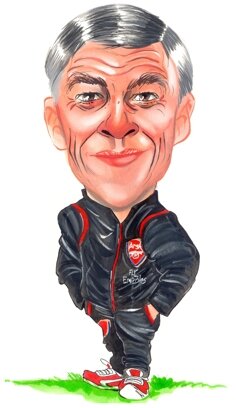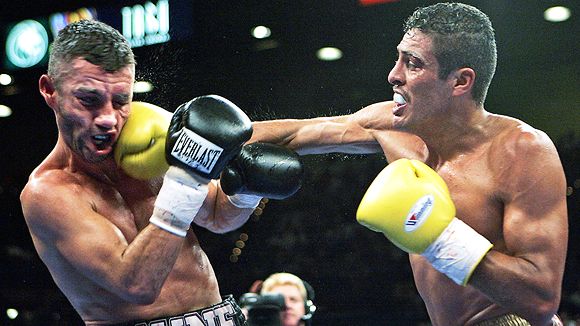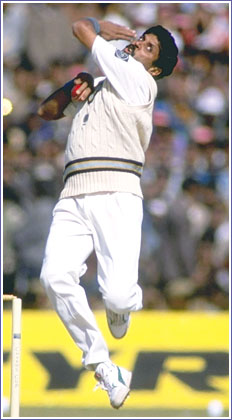Borg vs McEnroe, Spurs vs Arsenal, Palmer vs Nicklaus, Federer vs Nadal, Michigan vs Ohio State, Lakers vs Celtics, the list of great rivalries is endless. Few things fascinate and engage the followers of sport as much as a great rivalry. It is often the yardstick by which greatness is measured. Six time world champion and Olympic gold medalist Sergei Bubka broke the world record 35 times and was the greatest pole vaulter of all time, but he never captured the popular imagination because no one came close to challenging him. There is some base human desire that gets enthralled by duels, whether lion vs slave at the Colosseum, or Federer vs Nadal at Wimbledon.
So the natural curiosity, given my predilection for lists and rankings, was to figure out the fiercest rivalries in sport. As subjective as which cheese tastes the best, but an interesting exercise nevertheless. To have some quantum of objectiveness, its divided into three un-mixable sections; individual rivalry, club rivalry and national rivalry. Here are the top 3 in each category:
Individual Rivalries
Number 3 for Individuals- Navratilova vs Evert
Rivalries last a few matches or a few years but very few individual rivalries last 14 years at the top level (from Evert's win in Italian Open final in May 1974 to Navratilova's win in Virginia slims final in Nov 1988 they faced off in 60 finals). The life time record of the two was 43-37 in favour of Navratilova, but most of Evert's losses came towards the end of her career. The dominance of the two was such that between 1982 and 1986, the pair won 18 out of 19 grand slams between them. Evert won 90% of all her matches. Navratilova had the longest winning streak of 74 consecutive matches. Evert has 157 singles titles, Navratilova has 167. Evert has 18 single major titles, Navratilova has 18 as well (
best male tennis player of all time has 14). Despite the rivalry they grew close and Navratilova even introduced Evert to her second husband Andy Mills. Fittingly, when Evert hosted Saturday Night Live in 1989, in the kick-off skit a Navratilova character showed up everywhere Evert was and outdid her at whatever she was doing. Their rivalry was intense, but always remained civil.
Number 2 for Individuals- Prost vs Senna
There are fierce rivalries and there are bitter rivalries but this one was fiercely bitter. Formula 1 racing is one of the most dangerous sports to start with but you know its getting personal when drivers start banging their cars into each other just to take their opponent out. This was the duel between the fire of Senna and the ice of Prost. In 1989 in the second to last race of the season in Suzuka, Prost drove into his team mate Senna, taking them both out of the race and in the process winning the drivers' championship. The next year Senna got even by driving into Prost at 190 mph on the very first turn of the same track and winning the championship. Honours even but the rivalry had turned bitter forever. When Prost Joined the Williams team in 1993, he had a clause inserted in his contract that prevented Senna from being his team mate that year. Later at the Interlagos circuit, Prost had to have a police escort, he was so reviled in Brazil. When he couldn't prevent Senna from joining Williams the following year, he chose to retire rather than be his team mate. By the end, Senna won 41 races with 65 pole positions and 3 championships while Prost won 51 races with 33 pole positions and 4 championships. Both have a legitimate claim to be the all time great of their sport. Unfortunately Senna died in a car crash at the Imola circuit in 1994. He had told a friend he realized after Prost's retirement how much of his motivation had come from competing against Prost. One million people showed up to Senna's funeral in Sao Paolo. Alain Prost was one of the pall bearers.
Number 1 for Individuals- Ali vs Frazier "It's gonna be a chilla, and a killa, and a thrilla, when I get the gorilla in Manilla".
"It's gonna be a chilla, and a killa, and a thrilla, when I get the gorilla in Manilla". While
Muhammad Ali entertained the world with his psuedo-rap, smacking a rubber gorilla in his hands, such words really got under Frazier's skin. He never forgave Ali for calling him "uncle tom" and the "white man's champion" prior to their first fight. What is not widely known is that Frazier had helped Ali through his boxing ban for refusing to serve in Vietnam by showing up at tribunal hearings in support and had even given Ali hundreds of dollars in cash to support him. Ali maintained that he said all these things to promote the fight but Frazier did not buy that and felt deeply betrayed. Their rivalry would become one of the most storied of all time and they would fight each other three times over their careers. Known as "the fight of the century", the first fight took place at Madison square Garden in 1971. Frazier had a 26-0 record with 23 KO's. Ali had a 31-0 record with 25 KO's. The fight also came to symbolize the anti-establishment camp in Ali and the pro-War movement in Frazier. Frazier won by unanimous decision after 15 rounds, but Ali gained respect for recovering from a
15th round knock down to finish a fight he had no chance of winning. Both fighters spent time in the hospital after the fight. Ali-Frazier II was also at Madison Square Garden in 1974. By this time Frazier had been demolished by Foreman so it was no longer a title contest, but the hostility between the two was still palpable. Promoting the fight on TV, both were reviewing their first fight when an argument led to a fist fight on the set and a fine for both boxers. In the ring later, Ali came away the winner by unanimous decision after twelve rounds. In October of 1975, the last and perhaps the best fight between the two took place, popularly known as "the thrilla in Manilla". Ali had beaten Foreman, Norton and Wepner since his last fight with Frazier and was riding high in confidence. He prepared lightly and was distracted by his torrid affair with Veronica Porche. Frazier on the other hand was seething with revenge and always managed to save his best for Ali. In the fight, Ali started strong but faded in the middle rounds and Frazier started punishing him. Legend has it that around the 6th round Ali whispered in Frazier's ear: "Joe, they told me you was all washed up" and Frazier barked back, "they lied" and followed it with a left upper cut. However, Frazier grew tired by the 10th and Ali managed to get enough jabs in that both Frazier's eyes swelled up. We would later find out that Frazier had a cataract in his left eye so was fighting almost blind for the last three rounds. Ali made it a one sided fight in the 14th round and Frazier's trainer Eddie Futch stopped the fight after the round, despite much protesting from his fighter. Author David Halberstam summed it up best: "the only way we know of Ali's greatness is because of Frazier's equivalent greatness, that in the end there was no real difference between the two of them as fighters."
Did not make the top 3: Borg vs McEnroe, Sampras vs Agassi, Federer vs Nadal, Palmer vs Nicklaus, Alydar vs Affirmed, Ted Williams vs Joe DiMaggio, Magic vs Bird, Jahangir vs Jansher, Imran vs Hadlee, Tendulkar vs Lara, Schumacher vs Hakkinen, Jeff Gordon vs Dale Earnhardt, Wilt Chamberlin vs Bill Russell, Hagler vs Hearns, Duran vs Leonard and Gretzky vs Lemieux.
Club Rivalries
Number 3 for Club Sports- Boston Redsox vs NY Yankees
The Redsox and Yankees have an embittered and fierce rivalry of over 100 years that is often referred to in America as "the greatest rivalry in sports". After Babe Ruth was traded to the Yankees in 1919, the Bosox were said to suffer from "the curse of the Bambino"- they failed to win a world series for the next 86 years, while the Yankees gathered 26 of them. It all changed in 2004 when Boston finally overcame NY and went on to win the world series- and then won it again in 2007. The Yankees haven't won since 2000.
Number 2 for Club Sports- Boca Juniors vs River Plate
Both teams are from Buenos Aires and matches between them are known as the "superclasico". Boca has a more working class following while River Plate has a more affluent fan base. One of Boca's stands is entirely of stacked boxes (called La "bonbonera" or chocolate box) while River Plate followers are called "Los Millionarios". The match thus adds an element of the class divide as well. There is huge following of the two clubs in the whole of Latin America and when the Observer newspaper made a list of "
50 sporting things you must do before you die", watching a "superclasico" in Buenos Aires was top of the list.
Number 1 for Club Sports- Celtic vs Rangers



There are 12 clubs that play football in the Scottish Premier League but only two that have ever won it. The Celtic-Rangers rivalry goes back to 1888 and the two teams are such a world apart, they even have a special name of their own: "the old firm". Religion, politics and social attitudes are all involved in old firm derbies, where the mostly Irish and Catholic supporters of Celtic are pitted against protestant republican followers of Rangers. There has been unfortunate instances of sectarian violence ensuing after games between the clubs. The rivalry is so fierce that only five players have ever moved between the two clubs in almost a hundred years. A study said admissions to hospital emergency rooms increases nine-fold over normal days on old firm match day weekends. It easily makes Celtic vs Rangers the most fiercely contested rivalry in all club sports.
Did not make the top 3: Redskins vs Cowboys, Ohio State vs Michigan, Galatasaray vs Fenerbahce, Inter Milan vs AC Milan, Real Madrid vs Barcelona, Arsenal vs Spurs, ManU vs Liverpool, Olympiacos vs Panathinaikos, Oxford vs Cambridge Crew, Boston Celtics vs Lakers, Notre Dame vs USC, Ferrari vs McLaren, Dinamo Zagreb vs Red Star Belgrade, Maple Leafs vs Canadiens.
Country Rivalries
Number 3 for National teams- America vs Europe in Golf's Ryder Cup
This rivalry has a relatively short history but the passion involved, including bitterness at fans behaviour towards players, is intense. The gamesmanship, the patriotism it espouses, the drama, the ridiculous outfits of the spouses, and some exceptional golf has made this biennial event one of the most anticipated sports event watched across the world. The score line is 8-7 in favour of the Europeans since it became Europe vs USA in 1979 and the intensity can be judged by the fact that there is always some bitterness voiced by the losing team. From walking across putting lines to prank calls in the middle of the night for opponents, its all been done in the Ryder Cup.
Number 2 for National teams- Brazil vs Argentina in football
Some of the best footballers in the world are from the the two countries. Between them they have won the world cup seven times. Brazil have won the World Cup 5 times and the Copa America 8 times, while Argentina have won the World Cup 2 times and the Copa America 14 times. Their close rivalry is reflected in their 35-34 record in favour of Brazil since their first match in 1914. Another dimension to the rivalry is often lent by the two players mentioned most for the title of greatest player of all time- Pele and Maradonna. In 1946 there were instances of broken legs during two consecutive games, which resulted in an abandoned game and fighting on the pitch with police. In the 1990 World Cup, Brazilians accused the Argentinian coaches of giving one of them water laced with tranquilizers (known as the "holy water scandal"). The amount of football passion involved makes any international meet between the two countries an all consuming affair for the fans.
Number 1 for National teams- India vs Pakistan in Cricket
Three wars in 60 years coupled with the religious fervour of cricket in the national psyche, provides for combustible ingredients for a passionate rivalry. Very few places in the world does sport, politics and religion mix in such a portent way. Traffic vanishes from the roads in the two countries of over a billion people when
India play Pakistan. In a previous trip to Pakistan during the World Cup, all TV sets and electricity generators were sold out in the market in anticipation of the cricket match. While the rivalry is statistically tilted in Pakistan's favour (leading Tests 12-9 and ODI's 68-45), India have managed to win all the World Cup encounters so far and also won the inaugural Twenty20 tournament by narrowly beating none other than Pakistan in the final. In 1986, Javed Miandad hit a last ball six for an improbable come from behind victory that lead to souring of cricket relations for a decade. The
1991 Pakistan tour of India had to be canceled because youths from the local extremist party Shiv Sena party dug up the pitch at Bombay's Wankhade stadium. In 1999, with Pakistan ready to tour India for the first time in 12 years,
Shiv Senna dug up the pitch at Delhi again but it was repaired in time. The Asian Test Championship match against India had to be finished in the eerie silence of an empty stadium after the 90,000 crowd at Eden Gardens Calcutta invaded the pitch as India inched towards certain defeat. And for all the mighty victories, Pakistan has never been able to top India when it's mattered most, in a World Cup. After one defeat to India in a World Cup, the Pakistani players had to go in hiding and father of ace bowler Wasim Akram was kidnapped by enraged fans. It often doesn't take much for this sibling rivalry to rise to the level of sheer lunacy.
Did not make the top 3: England vs Australia Ashes, USA vs USSR Ice Hockey, England vs Germany football, Australia vs USA swimming.




































































